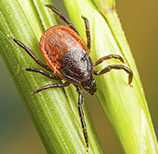Overview
Canine babesiosis is caused by an infection with the organism Babesia, which is frequently transmitted by ticks. It is a blood parasite that infects your dog’s red blood cells. It usually takes approximately 24–48 hours after attachment of the tick on your dog for the infection to be transmitted.

Clinical Signs
It will depend on the species of Babesia and the individual dog on how they will react when infected with babesiosis. The disease can be mild or severe, and your best friend may show obvious signs of being sick, or no signs at all.
Some of the most common signs are:
- Pale gums due to anemia (decrease in number of red blood cells)
- Anorexia (decreased appetite)
- Depression
- Difficulty breathing
- Weakness
- Fever
Diagnosis/Treatment
The scary thing about tick-borne diseases is that the signs are often vague and sometimes difficult to identify. If you live in an area where you see ticks, always keep a watchful eye on your dog. If you suspect he isn’t feeling well, you should contact your veterinarian immediately. To learn more, watch this video on protecting your dog from ticks.
If your veterinarian suspects your dog may have a tick-borne disease such as babesiosis, she will most likely recommend some blood tests. These may include:
- A complete blood count to see if your dog is anemic
- A blood film to look for the microscopic organisms in your pet’s red blood cells
- Other tests, such as PCR testing
If it is determined that your dog has babesiosis, your veterinarian will discuss which medications are right for them. These may include a drug called imidocarb dipropionate, which is known to be effective against Babesia Other medications may be used as well, and your veterinarian may suggest supportive care until your dog’s clinical signs improve. Ensuring that you give your pet all of their medication is paramount to their recovery.
Prevention
The key to preventing any tick-borne disease is tick prevention. Check your dog daily for ticks, and talk with your veterinarian about the right tick prevention medication for your best friend. Annual testing is also important to protect your dog from ticks. Learn more here.
If you have any questions or concerns, you should always visit or call your veterinarian – they are your best resource to ensure the health and well-being of your pets.
Beware the Bug By Dr. Ruth MacPete Anaplasma is spread by ticks. As the weather gets warmer and dogs spend more time outside, they’re more likely to be exposed to these creepy parasites and all of the diseases they carry. Read more> Or learn more about dogs and parasites > |

